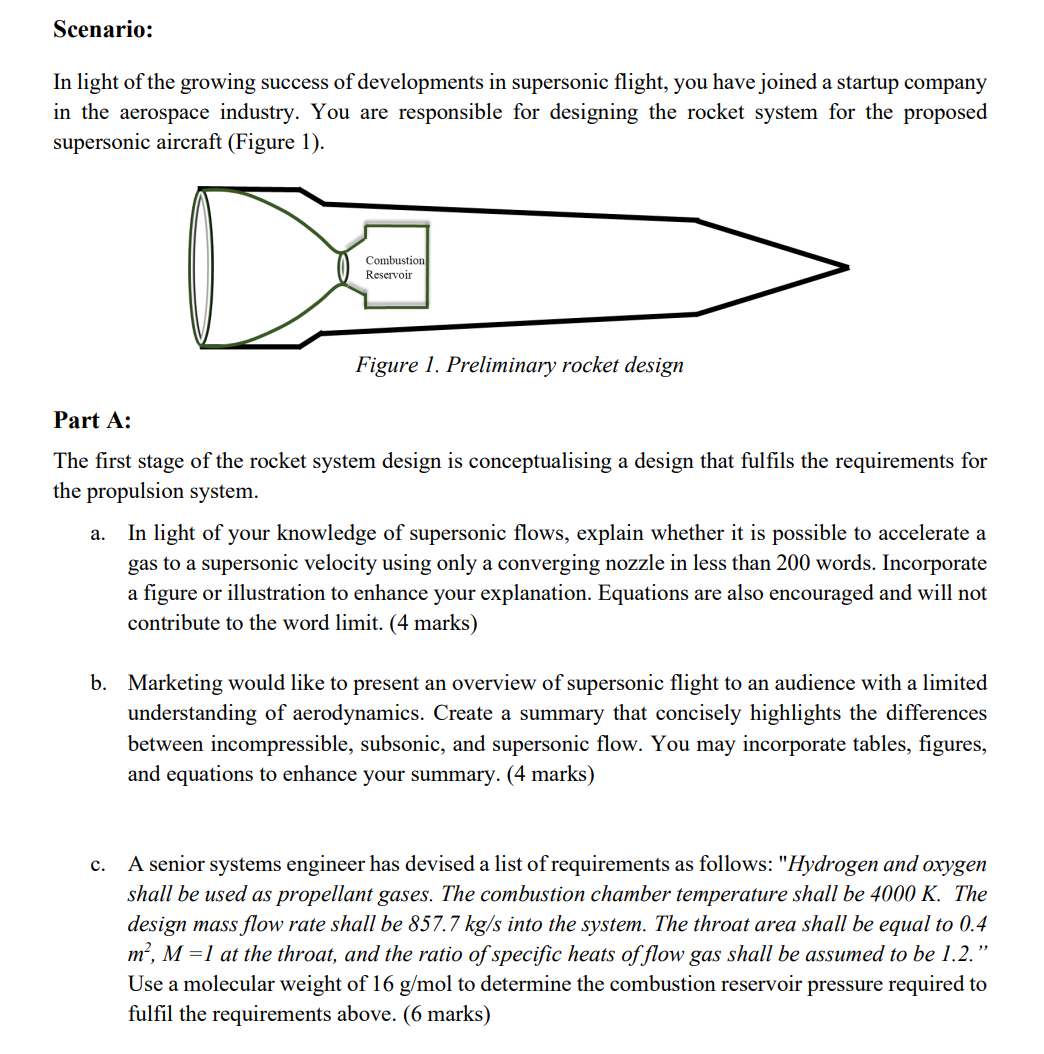Answered step by step
Verified Expert Solution
Question
1 Approved Answer
Scenario: In light of the growing success of developments in supersonic flight, you have joined a startup company in the aerospace industry. You are



Scenario: In light of the growing success of developments in supersonic flight, you have joined a startup company in the aerospace industry. You are responsible for designing the rocket system for the proposed supersonic aircraft (Figure 1). Combustion Reservoir a. Figure 1. Preliminary rocket design Part A: The first stage of the rocket system design is conceptualising a design that fulfils the requirements for the propulsion system. In light of your knowledge of supersonic flows, explain whether it is possible to accelerate a gas to a supersonic velocity using only a converging nozzle in less than 200 words. Incorporate a figure or illustration to enhance your explanation. Equations are also encouraged and will not contribute to the word limit. (4 marks) b. Marketing would like to present an overview of supersonic flight to an audience with a limited understanding of aerodynamics. Create a summary that concisely highlights the differences between incompressible, subsonic, and supersonic flow. You may incorporate tables, figures, and equations to enhance your summary. (4 marks) C. A senior systems engineer has devised a list of requirements as follows: "Hydrogen and oxygen shall be used as propellant gases. The combustion chamber temperature shall be 4000 K. The design mass flow rate shall be 857.7 kg/s into the system. The throat area shall be equal to 0.4 m, M = 1 at the throat, and the ratio of specific heats of flow gas shall be assumed to be 1.2." Use a molecular weight of 16 g/mol to determine the combustion reservoir pressure required to fulfil the requirements above. (6 marks) Part B: Your team has now shifted to the external geometry of the rocket system for the next design phase. a. To aid the commercial team, your experimental testing team has designed a similarly shaped rocket and tests it with the flow conditions shown in figure 2. At the location where the Pitot tube is shown in figure 2, the static pressure is measured to be 48.3 kPa. Assume Cp, R and y are 1.005 kJ/kg.K, 0.287 kJ/kg.K and 1.4, respectively. Determine the velocity at the location of the Pitot tube and state any assumptions made. Additionally, if the flow is assumed to be incompressible, quantify the percentage error. (6 marks) Pitot tube C. Velocity = 310 m/s Density=0.81 kg/m Free stream pressure = 0.71 atm Figure 2. flow conditions tested. b. For the next phase, the experimental testing team must test the rocket system at supersonic speeds. To aid your team in this task, you have been asked to design a supersonic wind tunnel facility that will produce supersonic flow at standard sea-level conditions. Testing will be performed at M = 3 with a design mass flow rate of 15 kg/s. The initial stages of the design will involve calculating the pressure and temperature of the reservoir. An estimate of the throat and exit areas will need to be calculated as well. State any assumptions you have made. (4 marks) A junior engineer who has only recently been recruited to the team has identified the different surfaces where they think the flow properties will change on the external surface of the rocket. They have labelled these surfaces with letters as per figure 3 below. You have been assigned the responsibility of reviewing whether they have correctly labelled all of the surfaces that will be exposed to different flow conditions. Answer with either 'Yes' or 'No', documenting a justification for your review result. (2 marks) Combustion D Reservoir SYMMETRICAL Figure 3. Junior Engineer - labelled geometry with flow conditions. Ma = 3 P = 45 kPa d. Based on your review of the junior engineer's work in c., you are tasked with using your knowledge of shock-expansion theory to calculate the Mach number, Prandtl-Meyer function and pressure for all faces that will be exposed to changing flow conditions as shown in figure 3. To ease your manager's workload, summarise your findings in a table similar to Table 1 shown below. (19 marks) Table 1. Summarise your solutions in a table like this. Prandtl-Meyer Function v(M) Face/Properties A B Mach number (M) Pressure (P)
Step by Step Solution
★★★★★
3.39 Rating (149 Votes )
There are 3 Steps involved in it
Step: 1
Part A a Acceleration to Supersonic Velocity with a Converging Nozzle To accelerate a gas to supersonic velocity using only a converging nozzle we nee...
Get Instant Access to Expert-Tailored Solutions
See step-by-step solutions with expert insights and AI powered tools for academic success
Step: 2

Step: 3

Ace Your Homework with AI
Get the answers you need in no time with our AI-driven, step-by-step assistance
Get Started


